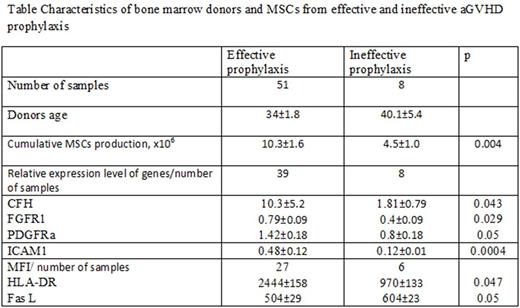Abstract
Introduction
Multipotent mesenchymal stromal cells (MSCs) are widely used for the prevention and treatment of acute graft versus host disease (aGVHD) after allogeneic bone marrow transplantation (allo-BMT). In some cases prophylaxis of aGVHD failed. The reasons of the failure could be either the result of particular qualities of donor-recipient interaction, patient status or differences in MSC samples. In order to discriminate effective and ineffective for aGVHD prophylaxis MSCs the growth and differentiation characteristics, relative expression levels of different genes and changes in the expression of surface MSC molecules during co-cultivation with activated lymphocytes were investigated in all MSC samples.
Methods
MSCs from the bone marrow of corresponding hematopoietic stem cells donor were injected into 59 patients after allo-BMT at the moment of blood count recovery. MSCs from the bone marrow of those donors were analyzed by cultivation in standard conditions (aMEM, 10% fetal calf serum) for 3 passages. Relative expression level (REL) of 30 genes involved in proliferation, differentiation and immunomodulation was estimated by RT-qPCR in all MSC samples. MSCs were seeded 105 cells per T25 flask, and then 106 allogeneic lymphocytes from single donor were added to all MSCs cultures. For lymphocytes activation 5 mg/ml phytohemagglutinin (PHA) was added to half of these cultures. Lymphocytes were removed from MSCs on 1st and 4th days of co-cultivation. Than trypsinized MSCs were collected from the bottom of the flask and expression of HLA-DR, HLA-ABC, CD73, PD-L1, CD54, CD80, CD86, CD105, CD146 and FAS-L on their surface was measured by flow cytometry. p<0.05 was considered statistically significant, all data is present as medium ± SEM.
Results
The injection of MSCs reduced the incidence of aGVHD 2 times and increased the 5 years overall survival of patients (p=0.047). Eight of 51 MSC samples had been ineffective for preventing aGVHD. Analysis of individual donor characteristics (gender, age, body mass index) found no significant differences between the MSCs, effective and ineffective for preventing aGVHD. REL analysis of 30 genes involved in proliferation, differentiation and immunomodulation in MSCs reviled only 4 genes differs significantly between effective and ineffective MSC samples (table). During 4 days of cultivation the MFI of HLA-DR did not change on MSCs. When MSCs co-cultivated with non-activated lymphocytes for 4 days MFI of HLA-DR increased only in 1.3 fold (p=0.03). Co-cultivation of MSCs with activated lymphocytes led to 7 fold increases in HLA-DR expression between 1st and 4th days (p≤0,001). On 4th day of co-cultivation MSCs with activated lymphocytes the MFI of HLA-DR was 3 fold lower in ineffective MSC samples than in effective (table). These data indicate that the effectiveness of MSCs used depends on the degree of their immunogenicity and, accordingly, on the immunomodulating potential. Among studied molecules only Fas L was significantly lower in effective MSC samples than in ineffective (table). It is possible that such MSC samples survived in the organism better than ineffective and their immunomodulating function lasts longer in the organism.
Conclusions
In summary, this study showed that MSC injections resulted in a significant 2-fold decrease in aGvHD development compared with the standard prophylaxis treatment. When compared with ineffective MSC, effective MSC samples are characterized by higher total cell production and REL of CFH, FGFR1, PDGFRa, and ICAM1. ExpressionofHLA-DR increased significantly in MSCs co-cultivated with lymphocytes, so these cells became immunogenic in organism. It is evident that the level of HLA-DR expression on MSCs important for MSCs efficiency in aGVHD prophylaxis. It is possible to predict efficiency of MSCs injection by simple test of co-cultivation of these cells with activated lymphocytes and measuring the expression level of HLA-DR on them.
The materials are supported by grant from the Russian Science Foundation, Project № 16-15-00102
Shipounova: Russian Foundation for Basic Research, Project № 15-04-02514: Research Funding.
Author notes
Asterisk with author names denotes non-ASH members.


This feature is available to Subscribers Only
Sign In or Create an Account Close Modal